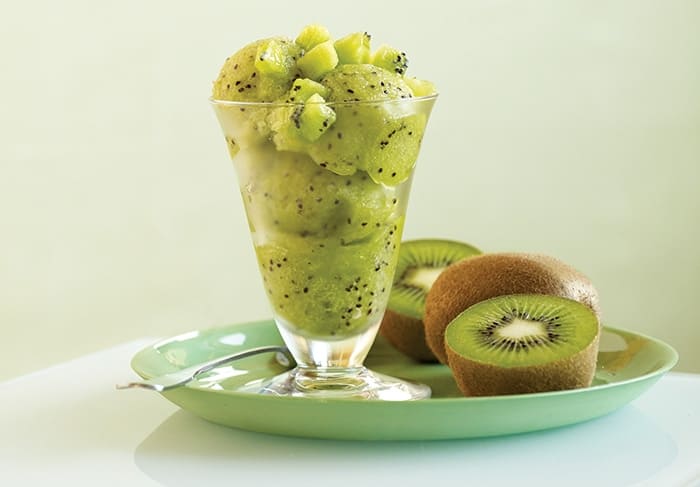
Although an icon of New Zealand, kiwifruit originated in China and was known as the Chinese gooseberry. Its name was changed to kiwifruit for market appeal when New Zealand began to export the fruit.
Most people eat kiwifruit raw, peeled and sliced or cut in half and scooped out with a spoon, but its skin is an edible source of fiber. Kiwifruit’s bright flesh ranges from emerald green to golden yellow, with tiny, edible black seeds and a unique sweet-tart flavor that some describe as a cross between a strawberry, pineapple, melon and banana.
Kiwifruit sweeten after picking. Ripe kiwifruit yield to gentle pressure, firmer ones ripen in a few days if left at room temperature, and they become mushy when they’re past their prime. Kiwifruit can be stored in the refrigerator for up to two weeks. Store kiwifruit apart from other ethylene-producing fruit to prevent over-ripening.
Kiwifruit contain a unique enzyme called actinidin, which is an excellent meat tenderizer. Rub a sliced kiwifruit half over meat or mash kiwifruit and spread it on top. Actinidin breaks down proteins in dairy products and prevents gelatin from setting; in recipes, add kiwifruit just before serving. Heating actinidin inactivates it, so you can also cook kiwifruit for a few minutes before adding it as an ingredient.
How to Use Kiwifruit
Kiwifruit add not only a gorgeous hue, but a delightful sweet-tart flavor to dishes and drinks. It is a colorful ingredient in fruit salads, and chefs are finding new ways to make kiwifruit shine on menus.
Toss diced kiwifruit into Mediterranean couscous or chicken salad. Shake up creative cocktail concoctions by adding pureed kiwifruit to drinks. Kiwifruit’s natural acidity adds zip to salsas, chutneys and jams. Mashed kiwifruit blended with honey and lime juice makes a tasty salad dressing. Kiwifruit’s flavor complements meats such as teriyaki steak, pork roast and ham. A staple on fruit tarts, kiwifruit is also delicious as a chunky topping for shortcake, frozen as sorbet or in dessert sauces. Kiwifruit are prominently featured on a favorite Down Under version of pavlova: meringue topped with whipped cream and sliced strawberries, passion fruit and kiwifruit.
In foodservice, almost all kiwifruit is sold fresh, although you may find it as a frozen puree. Fresh kiwifruit are typically available in one- to four-pound clamshells and are usually shipped in 20-pound containers.
Kiwifruit is available year-round, with producers in New Zealand and Chile tag-teaming spring production while California growers harvest in the fall. The main varieties of kiwifruit are the popular, bright green Hayward variety, the patented gold variety with a sweeter, more tropical taste and baby kiwifruit (about the size of a grape).
Kiwifruit's Health Benefits
They say to never judge a book by its cover, and in the case of kiwifruit, that’s certainly true. You’d never guess from its fuzzy brown exterior that there’s a bright, beautiful color and pretty pattern of black seeds inside — and a treasure load of nutrition, too. One medium kiwifruit provides about 60 calories, 100 percent of daily vitamin C needs and more potassium than half a banana.
Kiwifruit also offer fiber and phytochemicals, including phenolics and carotenoids. Research has found that eating kiwifruit daily may help reduce the risk of cardiovascular disease through antioxidant activity by helping to increase HDL cholesterol. Regular consumption has also been linked to beneficial effects on immune response related to cancer and improved gut health.
Kiwifruit should be avoided by individuals with a latex allergy or at risk for latex sensitivity. Consumption may result in a serious reaction leading to anaphylaxis. Kiwifruit are high in oxalate, so those with kidney urinary stones may also need to avoid eating them. Additionally, kiwifruit are high in potassium, which may be a concern for patients with kidney disease.
Kiwifruit Sorbet
Developed by Alejandro Ramos
Ingredients
1 cup water
3/4 cup sugar
1 vanilla bean
3 anise star pods (optional)
10 kiwifruit, peeled and cut in half
2 Tbsp. rum or vodka (optional)
1 tsp. fresh lemon juice
Directions
- In a medium saucepan, combine water and sugar; bring to a boil until sugar is dissolved.
- Lower heat and simmer for 2 to 4 minutes or until water reduces slightly.
- Turn off heat; add vanilla bean and anise pods. Cover and let cool at room temperature.
- Once cool, remove vanilla beans and anise pods; reserve syrup.
- Using a blender or food processor, puree kiwifruit until smooth. Whisk together kiwifruit, cooled syrup, rum and lemon juice. Pour into ice cream maker and freeze according to manufacturer's instructions. Once frozen, transfer sorbet into an airtight container and store in freezer for up to 2 weeks.
Preparation Note
Alcohol helps keep the sorbet soft and scoopable. If not used, sorbet will freeze harder, so it should be removed from the freezer 10 minutes before serving.
Nutritional Info
Serves 10. Serving size: 1/2 cup
Calories: 100
Total fat: 0.5g, Saturated fat: 0g, Trans fat: 0g
Cholesterol: 0mg Sodium: 0mg
Carbohydrate: 25g, Fiber: 2g, Sugar: 22g
Protein: 1g
Alejandra Ramos blogs at AlwaysOrderDessert.com
Kiwifruit Teriyaki Marinade
Contributed by California Kiwifruit Commission
Ingredients
2 kiwifruit, peeled
1/4 cup dry white wine
1/4 cup reduced-sodium soy sauce
1/4 cup brown sugar, packed
1 clove garlic, minced
1 tsp. fresh ginger root, grated
1 Tbsp. vegetable oil
Directions
- Using a blender or food processor, puree kiwifruit. Combine with wine, soy sauce, brown sugar, garlic, ginger and oil.
- Pour marinade over meat for 30 minutes; remove meat and discard marinade.
- Makes enough mariade for 1 1/2 to 2 pounds of meat.
Nutritional Info
Serving size: 1 tablespoon
Calories: 30
Total fat: 1g, Saturated fat: 0g, Trans fat: 0g
Cholesterol: 0mg, Sodium: 140mg
Carbohydrate: 5g, Fiber: 2g, Sugar: 4g
Protein: 0g
For more recipes, visit Kiwifruit.org
